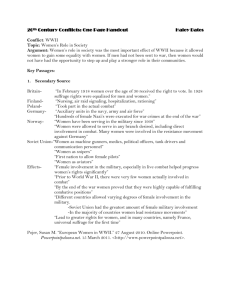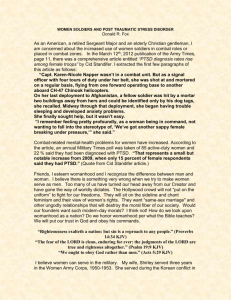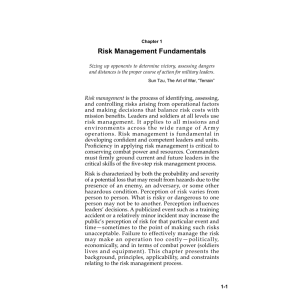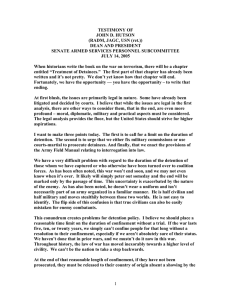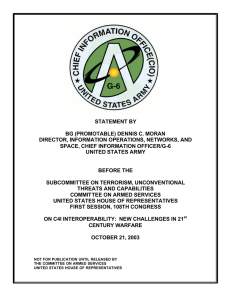V. Preparing for War
advertisement
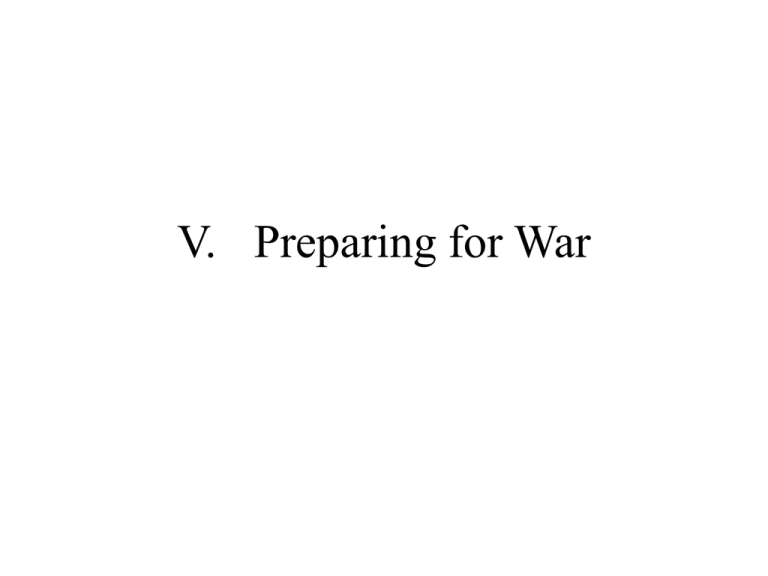
V. Preparing for War A. Basics of War • Offensive- army chooses to advance on the enemy • Defensive- army protects itself from the enemy • Campaign- series of battles & engagements intended to accomplish assigned strategic objectives • Strategy- the science of designing campaigns to achieve objective of war • Tactics- art of employing armed men in combat B. Three Questions to Creating a Strategy • 1) What are you trying to do? – Connection between political objectives & conduct of war – North: Squash rebellion/restore the Union – South: gain & maintain independence • 2) What do you have? – Resources – Manpower, Food, Industry, Material, Finances – Morale (Nation’s will) • 3) How are you going to use what you have? C. Nine Principles of War Objective Simplicity Unity of Command Offensive Maneuver Mass Economy of Force Surprise Security D. Developing Campaigns What type of campaign will you conduct? • Offensive – Break the will of the enemy – Battlefield Dominance – Destroy political & military structure – Make quick, decisive 1st move – Prevent escape • Defensive – Wear down the enemy – Break the will to fight – Protect vital areas – Do not allow attacker to use superior force – ESCAPE ROUTES E. Communication & Supplies • Supply – Stockpiled close to the lines – Boats & trains were used to carry supplies (1 week) – Wagon trains 5-20 miles long carried immediate supplies (food & ammunition) – Should never be cut – Live off land • Information (intelligence) – – – – Telegraph Couriers Scouts Supply train & boats – Cavalry – Never leave the army blind – orders Rear Attack: unsuspected attack from behindinflicts the most damage (usually to supply lines) Flank attack: strike the enemy from the sides collapsing their line Frontal Assault: head on attack, least desired and uses the highest combat force Main attack: bulk of combat force to win quickly & decisively Reinforcements: additional combat power Supporting Attack: small group that creates a diversion Feint: deceiving an army to think the main attack is coming from another direction Critical Terrain: Fence rows Stone walls Trenches Ridges Hills G. Civil War Army Organization • Cavalry – – – – Eyes & Ears of the army Lightly armed Vast moving capabilities Perform screens & raids/ Reconnaissance • Artillery – Long-reaching fire power – Usually set up behind infantry for support • Infantry – Foot soldiers/ Bulk of combat force – Occupy terrain/ attack & defend Other Branches • Quartermaster – Oversees supplies – Provides rations for food & ammo – Supervised supply trains (25 wagons/1000 men) • Medical Corps – Treated casualties – Buried dead – Evacuated wounded • Signal Corps – Lines of Communication – Signal Flags – Mirrors – Torches – Balloons – Couriers – telegraphs • Army Corps of Engineers – – – – Built roads Fortifications Bridges Created terrain maps A. Northern & Southern Strategy • North: Anaconda Plan – Winfield Scott – Strangle south into submission – 3 objectives • 1) Capture Richmond • 2) Blockade Ports • Control MS River & cut CSA in half • South: Survival – Hold Critical territories – Control the MS River – Fight a defensive campaign on familiar ground B. Geography of War: Theatres 1 Eastern Theatre: Triangle Territory 2 3 4 1) Washington DC - Union Capitol 2) Richmond, VA - Tredegar Iron Works 3) Lynchburg, VA - Shenandoah Valley 4) Norfolk, VA - Chesapeake Bay • Shenandoah Valley was very important because of its food supply • It was also the gateway to the west from Virginia to Tennessee • Western Theatre – Appalachian Mountains to the Mississippi River – New Orleans to Vicksburg – 2 vital RR to the survival of the west • Chattanooga • Atlanta • Tran-Mississippi Theatre – West of the Mississippi River to New Mexico – No real fighting, but critical for food – Mexico was main trading partner Things that go BOOM 1853 Enfield Rifled Musket .577 caliber 1861 Sharps Carbine .52 caliber 8 inch Colombiad 24 lb Howitzer 1,800 yds @ 5° 1,322 yds @ 5° 10 lb Napoleon 1860 Army Colt .44 caliber 1860 Navy Colt .38 caliber Cannon Projectiles • Solid Shot – Large Round ball used for demolition – Long-range ordinance • Case Shot – Invented by Henry Shrapnel as long-range ordinance – Filled with little round iron pellets – Used charge to burst open and spray shrapnel • Grape Shot – Short-range ordinance – Filled with 9 iron ball shrapnel pieces • Cannister – Short-range “shotgun” blast of shrapnel – Most devastating of the projectiles Innovators of Firearms • Horace Smith & D.B. Wessen – Created the rim-fire cartridge – Established the Smith & Wessen Company • Samual Colt – Innovator of the Colt Revolver – Most widely used handgun in the Civil War • Oliver Winchester – Sold the Henry repeating rifle • Remington Arms Co. – produced the percussion musket What is the difference between Breech & Muzzle loading rifles?
